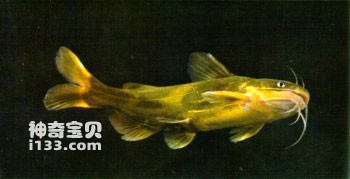Yellow catfish (Pelteobagrus fulvidraco) belongs to the order Catariformes, the family Pelteobagrus, and the genus Pelteobagrus fulvidraco. Commonly known as: Huang Lading, Yangsi. English name: Yellow cartfish.
The body is long, the abdomen is flat, and the rear part of the body is slightly flattened laterally. The head is large and flat, the snout is round and blunt, the mouth is large and downwardly positioned, both the upper and lower jaws have fine, downy teeth, and the eyes are small. There are 4 pairs of barbels, and most species have particularly long maxillary barbels. No scales. Both the dorsal and pectoral fins have well-developed hard spines, which can produce sounds when the spines move. Adipose fin short. The body is greenish-yellow, and most species have irregular brown markings; each fin is gray-black with yellow.

They mostly live a bottom-dwelling life in still water of lakes or slow rivers, and they especially like to live in shoals with decaying matter and silt. They lurk at the bottom of the water body during the day, float to the upper surface of the water at night to look for food, and mostly gather in the deep water of tributaries in winter. It has strong adaptability to the environment and can live in adverse environmental conditions. Yellow catfish is a typical polyphagous fish. Juveniles mainly feed on zooplankton and aquatic insect larvae, while adults feed on small fish and invertebrates. Yellow catfish reaches sexual maturity at the age of 2. From May to July every year, the male fish swims to the silt clay with dense aquatic plants along the coast (water depth 8-40 cm), uses its pectoral fin spines to rotate intermittently on the mud bottom, and digs a small mud pit, which is the place where eggs are laid. Fish nest. After the male fish builds the nest, he stays in the nest and waits for the arrival of the female fish to lay eggs and fertilize them in the nest. Spawning activities mostly take place at night when the climate changes from sunny to cloudy and rainy. After the female fish lays eggs, she leaves the nest to look for food. Only the male fish guards the developing eggs and larvae near the nest until the larvae can leave the nest and swim freely (about 7-8 days).
Yellow catfish is widely distributed and is found in all waters across the country except the western plateau. Although it is small in size, its yield is large. The meat is tender, without small thorns, and rich in fat. Its protein content is 16.1% and fat is 0.7%. It is a common edible fish in my country. There are many types of yellow catfish, and common species include long-bearded yellow catfish (P.eupogon, English name: Shorthead catfish), Vachellii (English name: Darkbarbel catfish), and glossy yellow catfish. (P.nitidus, English name: Shining catfish) etc. Both the dorsal and pectoral fin spines of the yellow catfish have venom glands, making it one of the most toxic freshwater stinging fishes. Severe burning pain occurs immediately after being punctured. The puncture often causes lacerations, bleeding, local swelling, and fever. The affected area is severely painful for half an hour to an hour before it stops.
The whole fish of yellow catfish is often used for medicinal purposes. Its meat is sweet and flat in nature, has the effects of dispelling wind and diuresis, and can be used to treat edema, laryngeal swelling and pain, etc.
animal tags:
We created this article in conjunction with AI technology, then made sure it was fact-checked and edited by a Animals Top editor.